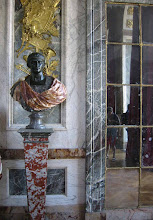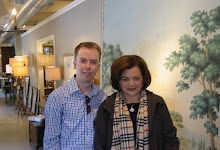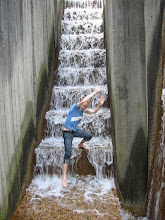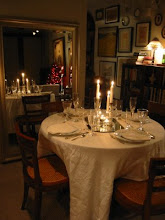Under heavy renovation and possibly finished by 2016, The Neues Palais (or new palace) in Potsdam is one of the more impressive structures in the area. Parts of Potsdam are basically a suburb of immense palaces, now nearly all museums. There are many excellent books available on the many palaces and the area itself.
The Neues Palais wasn't meant as a home for the King when it was completed in 1769 but rather as official state apartments for entertaining other royals and ambassadors. Therefore it was built to impress and not necessarily be very homey for the monarch who retained a small apartment in the palace.
Opposite the palace (above) are the Communs (seen below), creating an entry courtyard. The Communs held the kitchens, service spaces, and offices for the palace - a sort of 'downstairs' if you will. The king had underground passages built connect the Palais to the Communs so servants could get between the buildings unseen but also undeterred by weather.
The ornate interiors are astounding. Designed in the Baroque style favored by the king they're beginning to show traces of upcoming Neoclassicism. Frederick the Great didn't like the strict lines of Neoclassicism so you have to look hard though!
The palace was originally designed by Johann Gottfried Buring. Buring had completed other buildings in Potsdam for the king but was fired from the job after it was started after disagreements on the palace facade. Perhaps Buring wanted to bring in the 'new' Neoclassicm.
I don't know, I think some of the rooms look pretty Neoclassical to me, wouldn't you agree? They could have been remodeled at a later date.
The floors in the palace are stunning. The parquet floor above looks absolutely modern to my eyes.
Carl von Gontard took over construction of the palace after Buring's dismissal.
The salon above is really interesting -I love how the treatment continues to the ceiling.
Almost a sort of garden room. Also notice the modern light fixtures which are hung holding all of the modern necessities like security.
While these modern fixtures might seem strange to some, I like that they don't damage any of the delicate walls and finishes and stand separate and discreet as their own 'thing'. Europeans do this exceptionally well.
More gorgeous parquet floors, almost like fine furniture.
After awhile all of these grand rooms start to look the same; gold, gold, and more gold.
I think we need to bring back the use of bed niches.
I imagine particularly in the 18th century Germany the alcoves felt really cozy and warm before central heating.
More gorgeous painted paneling - chinoiserie here. No gold here!
The palace was later used by successive monarchs as a full time residence and it was therefore renovated with modern conveniences. I love the Victorian heat grate above.
But not all of the rooms are gold. A number of rooms are silver gilded like the bedroom below. I suppose the silver would reflect candlelight just as well if not better than the gold gilding.
As always thanks so much to my Australian penpal Neil for supplying us with these gorgeous images from his travels. If you find yourself in Berlin a visit out to Potsdam is really heavily encouraged: read more about visiting Potsdam palaces here.
Friday, November 14, 2014
Neues Palais, Potsdam
Labels:
architecture,
Germany,
history,
inspiration,
Interiors,
Neues Palais,
palaces,
penpal,
Potsdam,
travel
Subscribe to:
Post Comments (Atom)









































.jpg)




















.JPG)







































































10 comments:
Stefan I don't believe I have thank ed your pen pal for providing us with the fabulous images of so many wonderful landmarks and historical sites.
The floors here are most impressive and the ceiling decor flowing up from the walls is stunning!
Have a great (stay warm) weekend!
xoxo
Karena
The Arts by Karena
The chinoiserie painted panels are really lovely, which reminds us that there were several waves of chinoiserie influences in European art. I am assuming that in the couple of years before The Neues Palais was completed in 1769, chinoiserie influences were peaking.
The ensemble of buildings at Potsdam is just incredible. (And there's truly plenty of Neoclassicism for aficionados like myself!) Remarkable that nearly all have survived, and in such good, relatively original condition, when you think about what happened to the city center of Potsdam and close-by Berlin during WWII. Though the royal German history is not so interesting to me as, say, that of France or Russia, I would absolutely - love - to visit Potsdam one day...!
My favorite photo in this posting is of the grate — it's delightful that the baroque motif was carried through in such a utilitarian detail!
Wow!! these places are worth visiting ! never got a chance to be there, but I'm happy I saw it from your blog. :D
Another great post! The floors are really remarkable, each room is a unique design. They are not an afterthought by any means. Thanks for sharing your great photos!!
Oh Stefan I'd love to jump into Neil's suitcase and enjoy all his travel destinations, Gorgeous as always, thanks.
xo
I think that's so cool that he was able to go see all of these places when he traveled. The pictures are incredibly beautiful. I would love to do something like that. Do you know what he does for a living and how he got into that career? http://wagarch.com/about/index.html
I have always been so fascinated with architecture. I was able to do some traveling in Europe this past summer and I got to see so many famous and beautiful buildings. Architectural design is something that can really change of a building is viewed and seen. It can give a structure meaning and creativity. These are some really great photos of this building in Potsdam! http://wagarch.com/about/index.html
I visited Potsdam in the mid 70's and saw this castle. There is more gold in there than I had ever imagined anywhere! It was all so beautiful. xo Nancy
Post a Comment